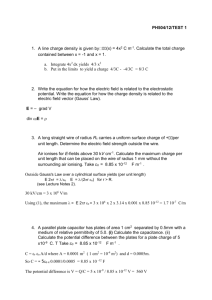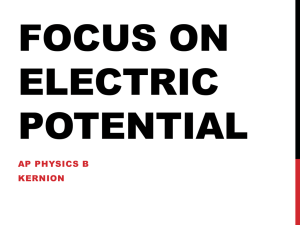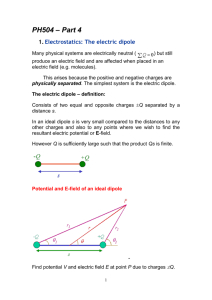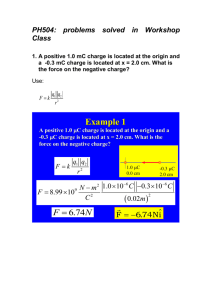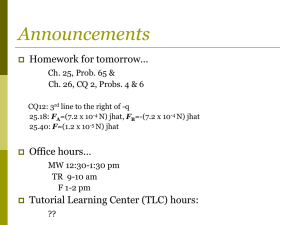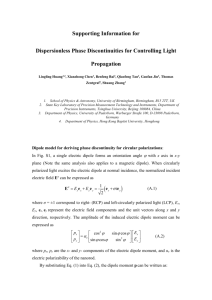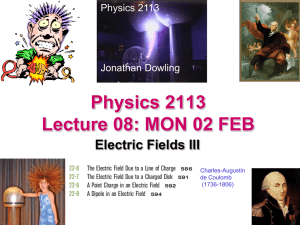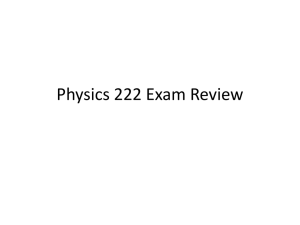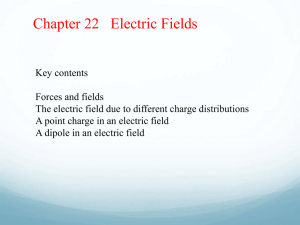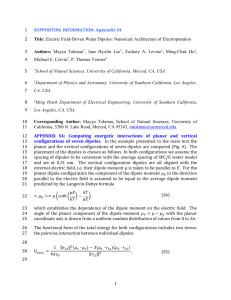Electric dipoles
advertisement
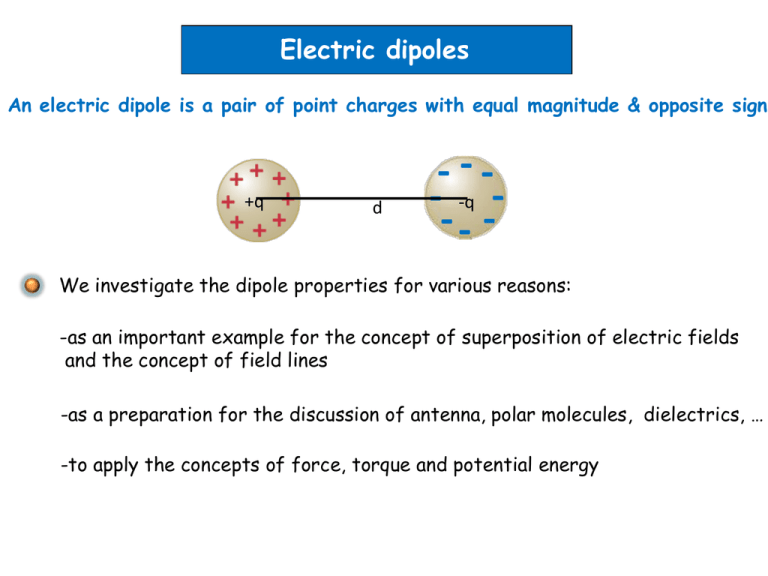
Electric dipoles An electric dipole is a pair of point charges with equal magnitude & opposite sign +q d --- -q -- - We investigate the dipole properties for various reasons: -as an important example for the concept of superposition of electric fields and the concept of field lines -as a preparation for the discussion of antenna, polar molecules, dielectrics, … -to apply the concepts of force, torque and potential energy Field of an electric dipole The total electric field E(r) is given by the superposition E(r)= E1(r) + E2(r) Let’s explore a few points graphically Analytically in the x-y-plane: Special case x=0: Y Ey 0 q1=+q Special case y=0: Ey 0 X q2=-q If we know electric field in coordinate system S how do we express it in coordinate system S’ To answer this question we have to look at the description of the position vector r in the two coordinate systems S’ S r =(x,y) r’ =(x’,y’) Y’ X’ d r=d+r’ E ( r’ ) =E ( r-d ) Let’s apply this transformation scheme to the electric field of a point charge 1 𝑞 ′ = 𝐸 𝑟 𝑟′ S 4𝜋𝜖0 𝑟 ′ 2 S’ Expressed in coordinates Y’ X’ d=(d,0,0) 𝐸𝑥 ′ (𝑥 ′ , 𝑦 ′ 𝑧′) = 𝐸𝑦 ′ (𝑥 ′ , 𝑦 ′ 𝑧′) 𝐸𝑧 ′ (𝑥 ′ , 𝑦 ′ 𝑧′) 𝐸 𝑟′ 1 =4𝜋𝜖 0 Using r’=r-d 𝐸 𝑟′ 1 𝐸 r = 4𝜋𝜖0 𝑞 (𝑥 − 𝑑)2 +𝑦 2 + 3 𝑧2 2 𝑥−𝑑 𝑦 𝑧 𝑞 2 𝑥 ′2 +𝑦 ′ +𝑧 ′ 2 𝑟′ 𝑥′ 𝑟′ 1 𝑟′= 𝑟′ = 𝑦′ 2 2 𝑥 ′2 +𝑦 ′ +𝑧 ′ 𝑧′ ′ 𝑥 1 𝑞 ′ = 𝑦 3 4𝜋𝜖0 ′2 2 2 2 𝑧′ ′ ′ 𝑥 +𝑦 +𝑧 As an exercise with relevant application let’s explore an approximate expression of the electric dipole-field on the x-axis for x>>d Y (x,y=0) q1=+q q2=-q d X We inspect the x-component of q 1 1 q Ex 2 2 4 0 d d x x 4 0 2 2 1 q E ( x, y 0) 2 4 0 d x 2 1 1 2 2 d x 2 dx d x 2 dx 2 2 x d /2 2 q d x 2 2 d x 2 0 x d / 2 2 d x 2 0 neglecting quadratic terms in d since x>>d Ex 2dx dq q 1 1 q x 2 dx x 2 dx q 2 4 2 2 2 2 4 0 x (dx ) 2 0 x 3 4 0 x dx x dx 4 0 x dx x dx qi r i We define the electric dipole moment p i for the case 𝑞𝑖 = 0 which here has only a x-component d d px ( q) ( q) dq 2 2 Ex px 2 0 x 3 Electric field lines Vector fields such as the E-field are somewhat abstract and hard to picture The concept of field lines can help us out E-field In this point field line Properties of field lines: -Imaginary curve such that tangent at any point is along the E-field in this point -density of field lines in a given region allows to picture the magnitude of the E-field At any particular point in space the E-field has a well defined direction Only one field line can pass through each point Field lines never cross Some examples Like the E-field, field lines point away from positive charges Closer to the charge, where E-field is stronger, higher density of field lines meaning more lines per volume E-field vector tangent to field lines Positive point charge Same properties can be found in other examples dipole Two equal positive charges Visualizing electric field lines Demonstration5B10.40 Clicker question The figure shows four possible arrangements of two identical electric dipoles with dipole moment p1 and p2. For which arrangement(s) are the 2 dipoles attracted to each other 1=A on clicker) A 2=B on clicker) B and C 3=C on clicker) C 4=D on clicker) A and D 8=E on clicker) B and C Water is a polar molecule that in good approximation is described as a dipole p Our definition of the electric dipole moment p qi r i i ensures that p is directed from the negative end to the positive Force and Torque on an Electric Dipole Total force: F F F 0 r r Field lines of a homogeneous E-field Torque: r F r F d 2qE sin qdE sin 2 pE sin Torque on an electric dipole in a field pE with pE sin Potential energy of an electric dipole in an electric field Let’s calculate the work done by the electric field on the dipole on rotation Ftan F cos F sin 2 r r From: W F dr W 2 F tan 0 r d 2 F tan 0 d d qE sin d 2 0 Takes into account d<0 W qdE cos cos0 p( )E p(0 )E With W U U p E pE cos Potential energy U of a dipole in E-field
